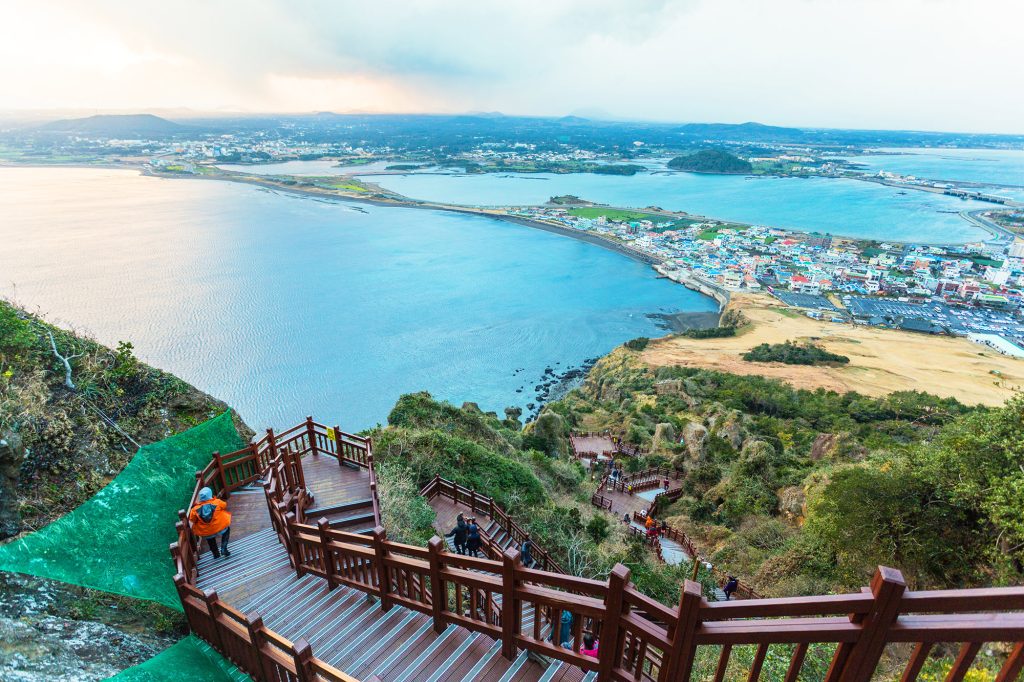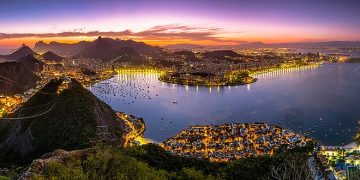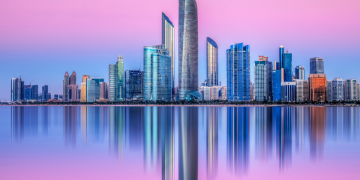Overview of Jeju Island
Jeju Island, located in the East Sea in the southwest of South Korea, is the largest island in South Korea, with a total area of about 1845 square kilometers and a population of about 660,000. The island is known for its unique natural scenery, rich cultural heritage and pleasant climate, and is known as the “Hawaii of Korea”. Jeju Island not only has volcanic landforms, Marine ecology and other natural landscapes, but also carries a long history and profound cultural heritage, and is one of the popular overseas tourist destinations for Chinese tourists.
Location and climate
Jeju Island is located between 32° and 33° north latitude, the same latitude as the northern Jiangsu Province of China, and has a subtropical maritime climate. Affected by the Japanese warm current, the island has a warm and humid climate all year round, with an average winter temperature of about 6 ° C and an average summer temperature of 33 ° C, and an average annual rainfall of more than 1000 mm, which is one of the warmest and highest precipitation areas in South Korea. Therefore, spring and autumn are the best time to visit Jeju Island, when the climate is pleasant and the scenery is beautiful.
Historical background and cultural characteristics
The history of Jeju Island can be traced back to the Neolithic Age, and many ancient sites and cultural relics have been found on the island, witnessing the long history of human reproduction here. During the Yuan Dynasty, Jeju Island was once part of China and later became a territory of South Korea. Because of its unique geographical location and natural environment, Jeju Island has formed a unique folk culture. The residents of the island make a living from agriculture and fishing, and have preserved rich traditional customs and festivals, such as the Jeju Horse Festival and the Haenyeo culture, demonstrating a lifestyle of harmonious coexistence between man and nature.

Famous scenic spot introduction
- Hallasan National Park
Hallasan, the symbol of Jeju Island, is one of the highest mountains in South Korea at 1,950 meters above sea level. Halla Mountain not only attracts numerous tourists with its majestic mountain and magnificent natural scenery, but also is known as the “exhibition hall of volcanoes” because of its unique volcanic topography and landform. The top of the mountain offers a beautiful view of the Seogwipo coast. Mountain flowers bloom in spring, green in summer, trees are dyed in autumn and white in winter. Visitors can choose to hike, camping and other ways, close to feel the uncanny workmanship of nature. - Seongshan Sunrise Peak
Located in the east of Jeju Island, Sungsan Sunrise Peak was formed by a volcanic eruption 100,000 years ago. Sunrise Peak is 182 meters above sea level, sand bowl shaped crater and surrounding 99 spires form a huge crown, spectacular scenery. This is the perfect place to watch the sunrise, and when the first rays of sunlight hit the sea level, the golden light meets the blue water, which is beautiful. Visitors can stroll along the Round Mountain Trail and enjoy the natural scenery along the way. - Teddy Bear Museum
The Teddy Bear Museum is the largest teddy bear museum in the world, displaying a variety of shapes and styles of teddy bears and related art. The interior design of the museum is full of children’s fun and creativity, providing visitors with a good place to take photos and interact with parents. Whether it is children who like teddy bears or adults who are childlike, they can find their own happiness here. - Dragon Head Rock
Located on the northern coast of Jeju Island, the dragon Rock was formed by a lava eruption two million years ago and is shaped like a dragon trying to fly into the sky. This naturally formed rock not only brings rich imagination space for tourists, but also becomes one of the iconic landscapes of Jeju Island. Visitors can take photos here and feel the magic charm of nature. - Land can be supported
Shichikake is a scenic harbor that is popular for its unique natural landscape and has been featured in many movies and television productions. The water is crystal clear and the sand is white and fine, making it an ideal place for swimming, sunbathing and sea views. Visitors can spend a leisurely afternoon here, enjoying the peace and beauty of the island. - Museum of Folklore and Natural History
The Museum of Folklore and Natural History is a great place to learn about Jeju culture, showcasing traditional folk customs and natural history of Jeju. The museum has a large collection of folk cultural relics and natural specimens, and through vivid exhibitions and explanations, visitors can have a deep understanding of the customs and natural ecology of Jeju Island.
Practical travel advice
- Mode of transportation
Plane: Jeju International Airport is the third largest airport in South Korea and is easily accessible. There are direct flights to Jeju Island from Beijing, Shanghai, Guangzhou and other cities in China, and the flight time is about 2-3 hours. There is also the option to transfer from Seoul to Jeju Island on a domestic flight.
Ferry: From Seoul or Busan, you can take a ferry to Jeju Island. The boat journey is long, about 10-12 hours, suitable for tourists who like to travel by sea.
Transportation on the island: Jeju Island is easily accessible, and visitors can travel by taxi, bus or car rental. The bus network covers the main attractions of the island, and the fares are affordable; Car rental road trip is more flexible and free, you can explore every corner as you like. - Accommodation recommendation
The accommodation options on Jeju Island range from high-end hotels to budget homestays. Here are some recommended places to stay:

Aewol Private Garden with Sea View Airport Jeju White M: Located in Awaeup, it is perfect for couples or families with free parking, air conditioning, Wi-Fi and other amenities. With an overall score of 4.87, this hotel is one of the most popular homestays in Jeju Island.
Mudita Jeju: Also located in Ayuki, it offers self-check-in with Wi-Fi, kitchen, hot tub and breakfast service. The overall score is 5.0, which is well received by tourists.
Poniente Jeju mellow: A large family friendly homestay with free parking, air conditioning, Wi-Fi and other amenities, with an overall score of 4.82.
- Food recommendations
Jeju cuisine is known for its unique flavors and rich variety. Here are some must-try food recommendations:
Roast Black pork: Jeju’s black pork is famous for its tender meat and delicate taste. The roasted black pork is fragrant and is one of the representative local dishes.
Seafood hot pot: Made from the rich seafood resources of Jeju Island, the soup base is delicious and rich, and the seafood is rich and diverse, which is a good place to taste seafood.
Pork trotter cabbage bag rice: The marinated pork trotter and white rice, lettuce and other ingredients wrapped together to eat, taste rich and diverse, endless aftertaste.
Orange Ice cream: Jeju’s oranges are famous for their sweet and juicy flavors, and orange ice cream is the perfect combination of orange flavors and ice cream.
- Tourism value and recommended tour time
Jeju Island attracts numerous tourists with its unique natural scenery, rich cultural heritage and pleasant climate. Whether hiking, watching the sunrise, visiting the museum or tasting the food, visitors can fully experience the beautiful scenery and unique charm of Jeju Island. Spring and autumn are the best time to visit Jeju Island, when the climate is pleasant and the scenery is beautiful; Summer is ideal for beach vacations.
Jeju Island is not only a tourist destination, but also an important window into Korean culture and history. Here, visitors can feel the warm hospitality and unique customs of the Korean people up close, and experience the harmonious coexistence of human and nature. As a result, Jeju is a must-see destination for both those who love nature and those who are interested in cultural exploration.





















